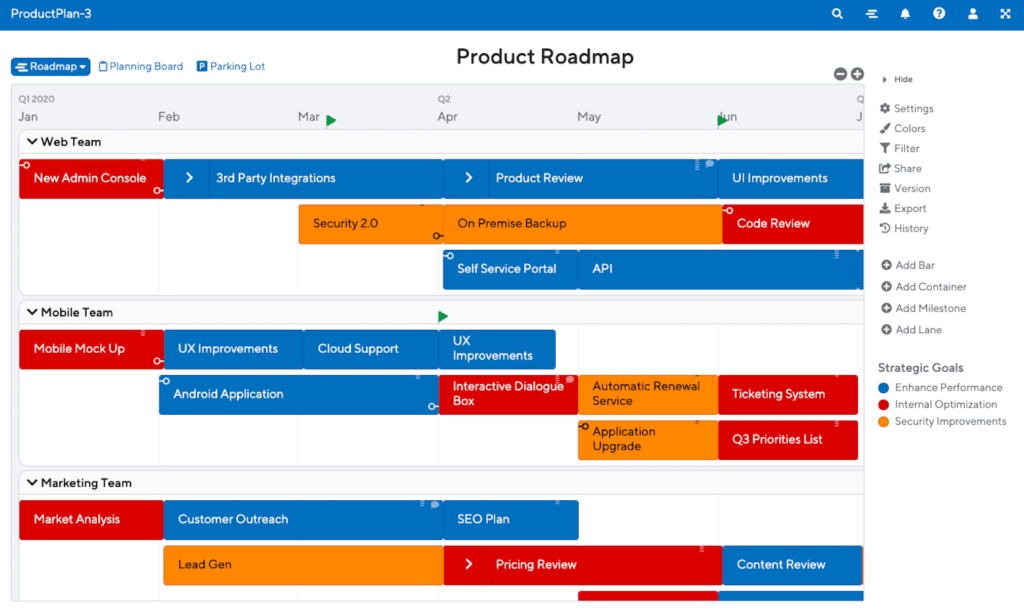What Is a Timeline Roadmap?
A timeline roadmap serves several strategic purposes. First, it communicates the priority order of a team’s initiatives based on when they plan to begin working on each one. Second, it communicates how long the team expects to spend on each project. Third, a timeline roadmap signals to the company about when to expect each initiative to be completed.
This type of roadmap contains a timeline across the top and all initiatives written in bars below the timeline. The person drafting a timeline roadmap will draw each bar long enough to depict the estimated start and completion times of that initiative.

When Should a Team Use a Timeline Roadmap?
Timeline roadmaps are among the most widely used roadmap styles. Businesses use timelines for many types of roadmaps. Here are just some examples. Note: We’ve linked to a template of each, which you can start using immediately to build your web-based roadmap.
- Product roadmap template
- Product launch-plan template
- Executive-facing portfolio roadmap template
- IT strategy template
- Agile roadmap template
- Business roadmap template
- Marketing plan template
- Engineering roadmap template
Most teams include timelines on their roadmaps because their initiatives have limited resources and budget and need to be completed in a specific timeframe.
When Should a Roadmap Not Include a Timeline?
There are instances, however, when a team will opt for a roadmap without timeframes. Here are a few examples.
1. The team is using the Kanban method.
The Kanban methodology of project management emphasizes frequent and continuous delivery of work instead of deadlines. These teams build a Kanban board, which consists of initiatives divided into columns that represent various stages of completion, such as “In Progress” and “Under Review.”
If your team follows the Kanban method, you might opt for a Kanban-style roadmap that did not include a timeline or deadlines.
2. The team plans to make their roadmap public.
Some product teams choose to share a version of their roadmap with customers, prospects, industry analysts, and other people outside the company. These teams reason that letting the public know what to expect next from the company’s products will keep customers interested and help build anticipation about new releases.
But including deadlines or expected release dates on a publicly available product roadmap can create problems. The company could miss a deadline. They might suddenly need to change priorities during development and redeploy resources onto another project. If these events cause a product release to be delayed beyond the timeframe suggested on the public roadmap, they could upset customers and cause the business to lose the public’s trust.
For these reasons, public-facing roadmaps should not include timelines.
Dive Deeper:
When Is it Smart to Share Your Roadmap Publicly? And When Would it Be a Disaster?
3. The team is sharing the roadmap with Sales.
It will also make sense to exclude timeline details for roadmaps that the product team plans to share with the sales department. Those roadmap discussions should focus on the solutions the product team is working on—and how sales will be able to use the new products to address challenges their prospects are facing. They should not force the product team to commit to specific release dates.
If the sales team sees completion deadlines for initiatives on the roadmap, they might begin telling their prospects too early about the availability of a new product. If the product team misses that date, the sales reps and their customers might be disappointed, and the company will lose credibility.
Download the Guide to Roadmap Software ➜
Should a Timeline Roadmap Include Specific Dates?
Even on an internal roadmap that only people in your organization will see, if you choose to include a timeline, you still need to determine how specific it is.
Some types of roadmaps, such as a release plan roadmap, will need detailed timeline information. A release plan might include specific dates that the team plans to complete each task.
But most types of strategic roadmaps, such as product roadmaps and IT strategy roadmaps, should focus on general timeframes. Keeping these roadmaps at a higher level—months or even quarters—will both help you manage stakeholder expectations and help your team focus more on delivering excellent work than meeting specific deadlines.
Related Terms:
Kanban roadmap / agile framework / scope creep / product strategy / go-to-market strategy
Learn More About Product Roadmapping
Read our book: Beginner’s Guide to Product Roadmaps